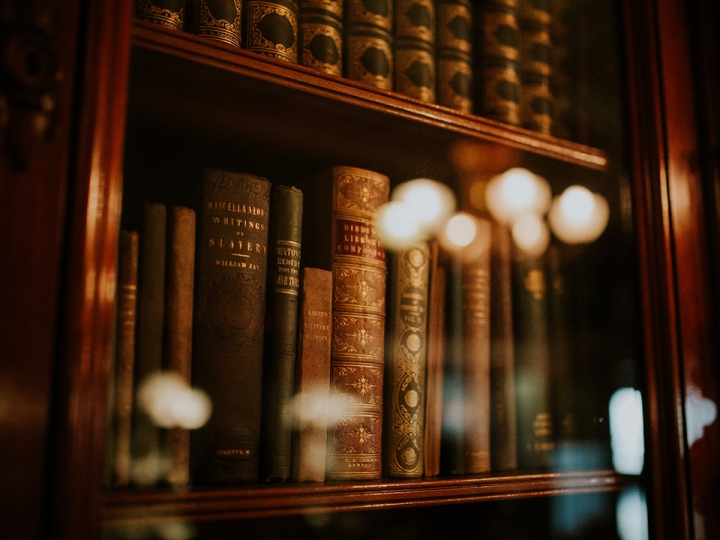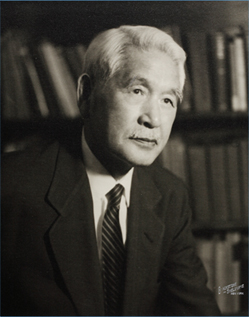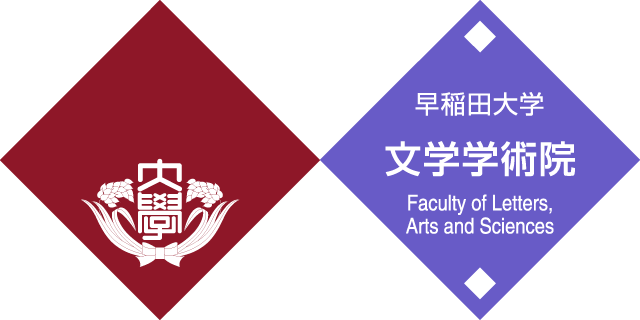- Research
- Profile of Tsunoda Ryusaku
Profile of Tsunoda Ryusaku

- An Unknown Giant
- The “Sensei” of Columbia University
- A Bridge Between Japan and the United States
- The Three L's
- A Brief Timeline
An Unknown Giant

Taken at Columbia University
Ryusaku Tsunoda was born in 1877 in Gunma Prefecture. In 1893, he began studying at Tokyo Senmon Gakkō (now Waseda University), where he attended courses taught by Hajime Onishi and Shoyo Tsubouchi.
After having built a career as an educator in Japan and Hawaii and arriving on the US mainland at the age of 40 in pursuit of further study, he spent the majority of his life in New York until his death at 87. Despite his successes in Japanese cultural research and education in the US, the name “Ryusaku Tsunoda” was not very well known in Japan. Donald Keene, famous for his translations of Japanese literature and Japanese studies research, spoke with respect and affection about his mentor Tsunoda. Combined with discussions of Tsunoda in Ryotaro Shiba’s “Gaidō o Yuku” essay series serialized in Shūkan Asahi, the figure of Ryusaku Tsunoda gradually became familiar to people in Japan.
The “Sensei” of Columbia University
During his half century of living in the United States—which included the painful period of World War II—Tsunoda continued undaunted to engage in research, education, and collecting documents. At Columbia University, where Tsunoda created the Japanese Collection at what is now the C.V. Starr East Asian Library and poured his energies into mentorship and collecting materials for the collection, it is said that the word “Sensei” refers to no one other than Ryusaku Tsunoda. This is not only due to what he, known as the “father of Japanese studies” at Columbia University, accomplished in his work. Students and others around him called him “Sensei” with respect and affection after encountering Tsunoda’s high degree of cultivation, sincere attitude toward learning, simple and unassuming lifestyle, and humble character.
A Bridge Between Japan and the United States
After arriving in New York, Tsunoda became Secretary (later General Secretary) of the New York Japanese Association. Tsunoda’s plans and eventual work to establish the Japanese Culture Center as a central facility for showcasing and researching Japanese culture were greatly focused on the collection, organization, and exhibition of Japan-related texts. In 1927, Tsunoda returned to Japan and worked vigorously to solicit donations for establishing a Japan-US cultural center within Japan and for the collection of texts. He obtained donations from the Imperial Household, political figures, businesspeople, and others. The collection he gathered was transferred to Columbia University in 1931, and Tsunoda served as its curator, preserving and organizing the works making up its contents. Tsunoda visited Japan and worked diligently to collect documents in later years as well. By pouring his energies not only into gathering materials for the Japanese Collection at Columbia University’s East Asian Library but also into organizing and cataloging the Collection, he ensured that it would continue to be expanded. The Collection is said to contribute to the studies of researchers from within and without the university and to be one of the leading such collections in the US to this day.
The Three L's
Sometimes when discussing culture, Tsunoda would use the phrase “the three L’s.” The idea was that one must consider things from the three aspects of “law,” “love,” and “labor” and that only through the interrelating and finding harmony between each of these three L’s could human society be enlightened. Ryusaku had a deep interest in Buddhism from a young age, and he sometimes explained this concept using the Buddhist terms hō, gan, and gyō, but he also discussed the concepts of each of the three L’s with references to US history and European culture. The three L’s could be described as a theory of culture and humanity with a broad perspective not bound to a single country or religion.
A Brief Timeline
| 1877 | Born in the village of Tsukuda in the Seta District of Gunma Prefecture on January 28 |
|---|---|
| 1890 | Enters Gunma Prefectural Jinjō Middle School |
| 1893 | Enters the Department of Literature at Tokyo Senmon Gakkō (now Waseda University) |
| 1896 | Graduates from the Department of Literature at Tokyo Senmon Gakkō |
| 1897 | Publishes Ihara Saikaku |
| 1899 | Publishes a translation of Benjamin Kidd’s Social Evolution Starts as a professor at Shingonshū Kyoto Kōtō Chūgaku-rin (now Shuchiin University) |
| 1900 | Starts second professorship at Bunchūen (now Kyoto Women’s University) |
| 1903 | Starts teaching at Fukushima Prefectural Fukushima Middle School |
| 1904 | Publishes a translation of Wilhelm Wundt’s Ethics |
| 1908 | Starts teaching as an instructor at Miyagi Prefecture Sendai First Middle School |
| 1909 | Arrives in Hawaii, appointed principal of Honpa Hongwanji Hawaii Middle School |
| 1914 | Publishes The Essence of Japanese Buddhism |
| 1917 | Edits Nihongo Dokuhon [A Japanese Reader] Arrives in New York, attends Columbia University and Clark University |
| 1918 | Inaugurated General Secretary of the Colorado Japanese Association |
| 1919 | Inaugurated Secretary of the New York Japanese Association |
| 1929 | The Japanese Culture Center established |
| 1931 | Appointed instructor of a Japanese history lecture at Columbia University The Japanese Culture Center becomes part of Columbia University Becomes curator of the Japanese Collection |
| 1948 | Retires as curator at Columbia University |
| 1962 | Conferred an honorary doctorate by Columbia University |
| 1964 | Dies in Honolulu on November 29 |
